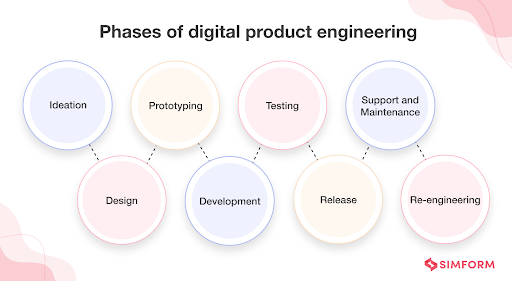The EdTech industry is constantly growing and embracing new technologies. With online learning becoming mainstream, companies need robust digital products. These products should scale seamlessly, offer a personalized experience, and integrate cutting-edge technology. This is where digital product engineering services play a crucial role.
This blog explores digital product engineering and key components. You’ll also discover advanced tools and challenges.
Understanding digital product engineering
Digital product engineering is an end-to-end process. It covers the complete lifecycle of a digital product including everything:
- Ideation
- Design
- Development
- Deployment
- Continuous improvement
Unlike traditional software development, digital product engineering emphasizes:
- Scalability
Solutions that grow with your business.
- Continuous improvement
Regular updates based on user feedback.
- Cross-functional collaboration
Developers, designers, testers, and business teams work together.
Key components of digital product engineering
Digital product engineering for EdTech involves several critical components. This ensures the delivery of reliable and scalable solutions. Here are the top four points to keep in mind:
- Product strategy and design
A well-defined strategy focuses on end-users—students, educators, and administrators. It also includes mapping out their needs and challenges.
Key steps in the product strategy phase:
- Identifying core product goals.
- Conducting market research to analyze competitors and user behavior.
- Building user personas to anticipate how different groups will interact with the platform.
- Creating wireframes and prototypes for user feedback.
By following a design thinking approach, EdTech companies can:
- Develop intuitive interfaces
- Cut user friction
This ensures that learners and teachers can navigate the platform with ease.
- Scalable architecture and development
A core pillar of digital product engineering is building scalable architecture. This helps to handle growth without sacrificing performance. This is critical for EdTech platforms that experience traffic surges during peak times. For instance, online exams, enrollment seasons.
Modern architectural approaches:
- Microservices architecture
Breaks applications into smaller, independently deployable services. This enhances flexibility and makes updates easier.
- Serverless computing
Reduces infrastructure management and automatically scale resources based on traffic.
- API-driven development
Ensures seamless integration with third-party tools. These include:
- Video conferencing
- Payment gateways
- Learning management systems (LMS)
- Quality engineering and continuous testing
Quality engineering (QE) helps you detect and resolve issues early.
Continuous testing techniques:
- Functional testing
Verifies that every feature works as intended.
- Performance testing
Ensures the platform can handle high user loads without crashing.
- Security testing
Protects sensitive student data from cyberattacks.
- Accessibility testing
It ensures an accessible platform for everyone, including disabled users.
- Cloud-native infrastructure
Most modern EdTech platforms are built on cloud-native infrastructure. It offers better scalability, flexibility, and cost efficiency. Cloud platforms provide the foundation for hosting, storage, and AI-driven analytics.
Advanced tools and technologies in digital product engineering
Advanced tools and technologies can help streamline development. It can also enhance the user experience.
- Artificial Intelligence (AI)
- AI-driven chatbots
Provide 24/7 student support.
- Recommendation engines
Personalize learning paths based on individual progress.
- Predictive analytics
Help educators identify struggling students early.
- Robotic Process Automation (RPA)
- Automate repetitive administrative tasks. These include grading and attendance tracking, allowing teachers to focus on teaching.
- Blockchain
- Improves security and transparency in credentialing and certification processes.
- Augmented Reality (AR) and Virtual Reality (VR)
- Creates immersive learning experiences for subjects like science, history, and engineering.
Addressing challenges with digital product engineering
EdTech faces several challenges that can slow down growth or compromise user satisfaction. Digital product engineering offers solutions for many of these issues.
- High traffic and performance issues
EdTech platforms experience significant spikes in usage, particularly during live classes or exams. Without proper preparation, these surges can cause slow performance or even crashes.
Solution:
- Implement auto-scaling cloud infrastructure to adjust resources in real time.
- Conduct regular load and stress testing to simulate high-traffic scenarios.
- Integration with multiple third-party systems
Many EdTech platforms need to integrate with external tools for:
- Video conferencing
- Payments
- Learning management
Poor integration can lead to broken functionalities or security risks.
Solution:
- Use API-driven development for seamless integration.
- Regularly test integration points to ensure data flows smoothly across systems.
- Security and data privacy concerns
A single security glitch can ruin an EdTech company’s reputation. It could also result in legal consequences.
Solution:
- Encrypt all data in transit and at rest.
- Implement multi-factor authentication and regular security audits.
- Stay updated with compliance regulations and best practices.
Real-world success stories in EdTech
Several EdTech companies have used digital product engineering to deliver game-changing solutions. Here are the top three examples:
Example 1: Adaptive learning platform
An EdTech startup launched a personalized learning app with AI and machine learning. The app optimized difficulty level of quizzes based on each student’s performance. Regular updates were done through continuous testing and agile methodologies. It helped the platform scaled to 1 million users within two years.
Example 2: Virtual classroom solution
A global EdTech provider created a virtual classroom platform with features like:
- Live video
- Collaborative whiteboards
- Breakout rooms
Example 3: Gamified learning experience
A gamified language-learning app used digital product engineering to integrate:
- Rewards
- Leaderboards
- Multiplayer challenges
User experience was improved based on analytics and feedback. It helped the app to keep engagement rates high and reduced churn by 20%.
Choosing the right digital engineering company for your EdTech business
Here’s how to choose the right partner:
- Proven experience in EdTech
Ensure the company understands the unique challenges in the education sector.
- Comprehensive QA capabilities
Focus on testing and quality assurance is essential to deliver bug-free products.
- Expertise in cloud and AI technologies
These are the building blocks of modern EdTech solutions.
- Agile and DevOps culture
This ensures rapid delivery and continuous improvement.
Conclusion
Online learning has come as a boon for students. It has also made education more accessible and affordable for the masses globally. But you need to deliver flawless experience. This is where digital product engineering services can help. It can help you drive innovation to meet the evolving needs of learners and educators.
Are you looking for trusted digital product engineering services? Qualitest can help you. They can help you deliver flawless digital experiences at scale. Speak to an expert now!







